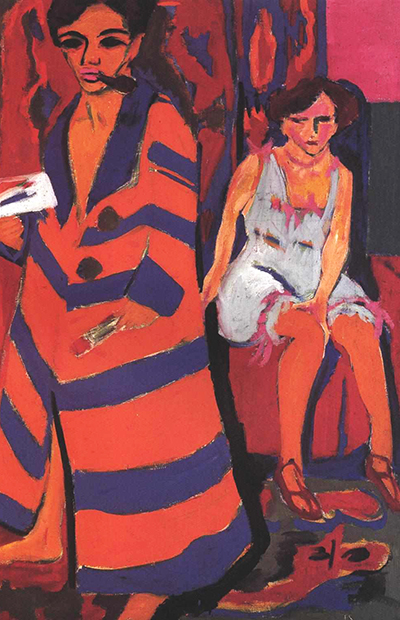Ernst Ludwig Kirchner was an emotional, sensitive being whose Expressionist paintings were driven by this connection to the world. Quotes from his life, both written and verbal, have helped us to form a more accurate picture of his life and career.
Famous Quotes by Ernst Ludwig Kirchner
Anyone who directly and honestly reproduces that force which impels him to create belongs to us.
A painter paints the appearance of things, not their objective correctness. In fact, he creates new appearances of things.
It seems as though the goal of my work has always been to dissolve myself completely into the sensations of the surroundings in order to then integrate this into a coherent painterly form.
All art needs this visible world and will always need it. Quite simply because, being accessible to all, it is the key to all other worlds.
People become artists out of despair.
If suffering can be transformed into creativity... I want to try it.
I begin with movement... I believe that all human visual experiences are born from movement...
You can do anything. Nothing is forbidden.
They [his 'Street Scene' paintings and drawings,he made in Berlin] originated in the years 1911-14, in one of the loneliest times of my life, during which an agonizing restlessness drove me out onto the streets day and night, which were filled with people and cars.
All art needs this visible world and will always need it. Quite simply because, being accessible to all, it is the key to all other worlds.
Every day I studied the nude, and movement in the streets and in the shops [in Berlin]. Out of the naturalistic surface with all its variations I wanted to derive the pictorially determined surface.
The technical procedures doubtless release energies in the artist that remain unused in the much more lightweight processes of drawing or painting (remark on printmaking).
Quotes about Ernst Ludwig Kirchner by Art Critics and Fellow Artists
Wherever he is and goes, he works. Pedestrians walk past the house, a carriage passes on the street, a visitor arrives, Kirchner takes everything as an occasion to create. Waiting for the streetcar, he draws the passers-by, he draws the audience in the concert, the figures on the cinema screen. No day goes by, even when he is traveling, when he does not make his notes.
E. L. Kirchner, discussing his drawings
He [Kirchner] dwelled here in a living situation that a bourgeois would deem uncharacteristic, materially simple, but sophisticated in his artistic sensibility. He worked feverishly, without concerning himself with the time of day.
Gustav Schiefler, an early sponsor of the artist
Kirchner lived in an Atelier that he had assembled out of an attic apartment. Every piece of furniture, every carpet was created by him. When one entered his room, one felt as if they were on another star or a faraway century.
Karl Theodor Bluth
[Kirchner's studio was] that of a real bohemian, full of paintings lying all over the place, drawings, books and artist's materials — much more like an artist's romantic lodgings than the home of a well-organised architecture student.
Fritz Bleyl
In the days that I spent in Dresden [before 1911].. ..I was together with Kirchner and Heckel a great deal.. .Here they led a singular bohemian life, liberated from any ordering of day-times and mealtimes; when they had the impulse they worked the whole night through and slept through the morning. I was convinced that they not infrequently lived on coffee, cake, and cigarettes.. .When the lamps were lit, we sat on benches and crouched over the batik-ed fabrics that were spread around the low table and looked at the portfolios with hand drawings and printed sheets; all the time strange, grotesque sculptures peered over our shoulders. The two showed me how they etched their lithographs, printed their etchings, and Kirchner drew two.. ..portraits of me with the dry-point needle.
Gustave Schiefler
More than any of the other artists, Kirchner translated the staccato rhythm of the music into visual means; the legs of dancers become solid entities and almost dashes in his 1910 Hamburger Tänzerinnen (Hamburg Dancers) (Fig. 34). All weight of this image is on the legs, as they are the largest parts of the scene and are rendered fully in black. Moreover, the repeating subject of the three dancers each doing identical leg lifts creates a vibrating back-and-forth. In this quick sketch, Kirchner manages to relay the unified spirit of this performance.
Claire Louise Albiez
A tragedy had been quietly enacted here over the last few months. Because of the defamation in Germany [in 1937 a total of 639 works by Kirchner were confiscated by the Nazi-regime: Degenerate Art] and the failure of the November exhibition in Basle.. ..he [=Kirchner] chose a radiantly beautiful day, 15 June, to put an end to his life. I shall spare you the details. He had been suffering grievously until he was able to make this decision.
Letter from his wife Erna Kirchner to Karl Hagemann




